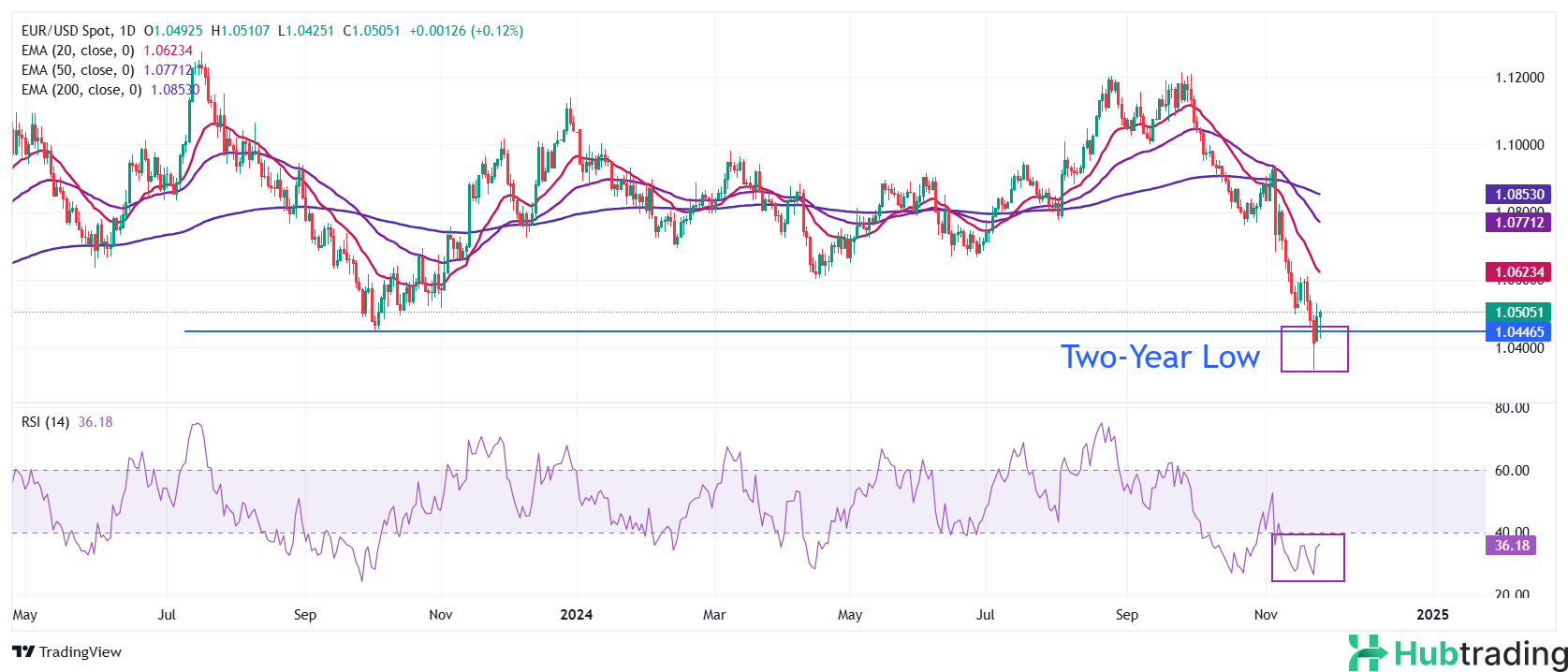- EUR/USD recovers, climbing back above 1.0500, as the US Dollar continues its corrective decline following Trump’s nomination of Bessent as US Treasury Secretary.
- ECB officials advocate for a gradual reduction in interest rates to mitigate the risk of entrenched inflation.
- Investors this week turn their attention to October's US PCE inflation data and the Eurozone's preliminary HICP figures for November.
EUR/USD erased intraday losses, climbing above the psychological resistance of 1.0500 during Tuesday’s European session. The pair recovered from a weak opening as the US Dollar (USD) gave up its daily gains.
The US Dollar Index (DXY), which measures the Greenback against six major currencies, initially surged near 107.50 during the Asian session. However, it retreated to around 107.00 in European trading hours, reflecting renewed pressure on the USD.
Renewed fears in Tuesday's Asian session temporarily bolstered the USD after President-elect Donald Trump threatened increased tariffs. Trump proposed a 25% tariff on Mexico and Canada and an additional 10% on Chinese goods, adding to the 60% tariff hike previously promised during his campaign. This rattled markets, although the initial surge in the USD proved short-lived.
The Dollar’s corrective decline resumed, continuing from Monday when Trump nominated hedge fund manager Scott Bessent as Treasury Secretary. Markets interpreted the move as a sign of potential fiscal discipline and political steadiness, prompting a pullback in the Greenback.
Investors are closely monitoring the FOMC Minutes, scheduled for release at 19:00 GMT. The November 7 meeting saw the Federal Reserve reduce borrowing rates by 25 basis points to a range of 4.50%-4.75%. These minutes could provide insights into the Fed’s stance on future rate changes.
Additionally, October’s US Personal Consumption Expenditure (PCE) Price Index, due Wednesday, will be a critical inflation gauge. This data is expected to shape expectations for the Fed’s December meeting, where traders remain divided over whether rates will be cut further.
Daily digest market movers: Eurozone Economic Concerns Persist
-
EUR/USD recovers intraday losses on Tuesday but remains under pressure as investors remain cautious. European Central Bank (ECB) policymaker and Bundesbank President Joachim Nagel highlighted ongoing economic challenges in Germany, the Eurozone’s largest economy, during a speech on Monday, according to Reuters.
-
“Germany is stuck in a period of economic weakness which has now lasted two and a half years,” Nagel stated, adding that “stagnation is likely in the final quarter of this year.” He also warned that Germany risks falling behind other countries in the bloc.
-
Despite concerns over growth, Nagel advocated for a cautious and gradual reduction in interest rates to ensure inflationary pressures are fully contained. “It is important to remain cautious and to loosen monetary policy only gradually and not too quickly,” he emphasized.
-
Similarly, ECB Chief Economist Philip Lane defended the ECB’s gradual approach to policy easing in an interview with French newspaper Les Echos on Monday. Lane noted that while inflation has eased, largely due to moderating energy costs, price pressures in the services sector remain elevated. He reiterated that inflation levels are still above the ECB’s target.
-
Investors will now turn their attention to the flash Harmonized Index of Consumer Prices (HICP) data for November, scheduled for release on Thursday and Friday. This data will provide insights into inflation trends across the Eurozone and its major economies. Economists predict the Eurozone’s headline HICP to rise to 2.4% year-on-year, with core HICP—which excludes volatile components such as food, energy, tobacco, and alcohol—expected to climb to 2.9%.
Technical Outlook: Bearish Bias Prevails

EUR/USD rebounded to 1.0500 but continues to face bearish pressure. All short-to-long-term Exponential Moving Averages (EMAs) indicate a downside trend.
The 14-day Relative Strength Index (RSI) has cooled after rebounding from oversold levels, suggesting a possible return of bearish momentum. Key support lies at the November 22 low of 1.0330, while resistance at the November 20 high near 1.0600 could challenge Euro bulls.
Despite its recovery, EUR/USD remains in a precarious position, weighed down by Eurozone economic concerns and market uncertainty surrounding upcoming US inflation data and Fed policy. Traders should prepare for heightened volatility as these key events unfold.





